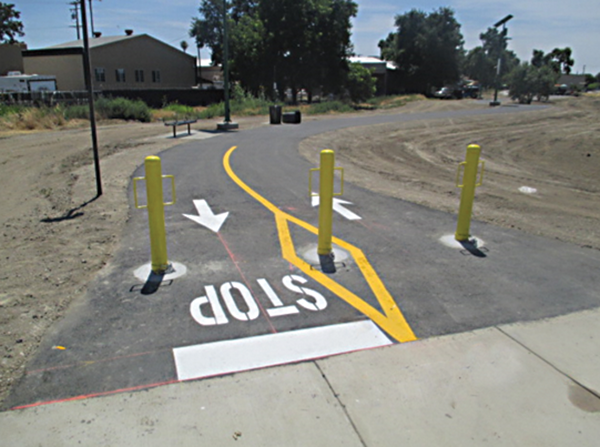Projects included new emergency communication center, repaving major roads, bike/walking trails
By Reggie Ellis
@Reggie_SGN
VISALIA– The City of Visalia began or completed more than $40 million in facilities, trails and road projects in 2017, most of it without touching funds generated by Measure N.
Community Development Director Nick Mascia provided the City Council with an update on many of the city’s capital improvement projects during a Dec. 18 presentation. Among the 50 projects mentioned in the report, Mascia said several key projects were completed in 2017, the largest being the Visalia Emergency Communications Center (VECC). Located at 420 N. Burke St. in downtown Visalia, the VECC houses 911 Dispatch, Fire Administration, the City’s Emergency Operation Center, the Traffic Management Center, and the City’s secure Data Center for Information Services. The estimated $28 million facility was funded using $8.5 million in Civic Center reserve money and another $600,000 from the General Fund. The rest, about $20 million, will be financed over the next 15 years through a combination of Police Impact Fees, Measure T (public safety tax measure passed in 2004) and the General Fund.
The only portion of the facility that is not complete and operational is the Traffic Management Center. The center has received a notice to proceed and may possibly be complete this month. The $1.6 million project is being funded with $1.1 million from the Congestion Mitigation and Air Quality (CMAQ) improvement program administered through the Department of Transportation.
The only project to require funding from Measure N was the street rehabilitation project on Ben Maddox Way. The original $2.1 million project, paid for with $1.4 million in federal transportation funds and $772,000 in Gas Tax money, only improved the roadway from Mill Creek to Houston Avenue. But an injection of $800,000 from Measure N allowed the city to complete an add-on project to extend the project north to the St. John’s River.
Burke Street was extended between Monte Verde and K Road using $1.5 million from Measure R, the half cent sales tax for transportation approved by county voters in 2006. More recently, the Tulare Avenue extension across Lovers Lane, was completed using a $2.5 million, no interest loan from TCAG. Stop signals were installed at the corner of Santa Fe and Center and Santa Fe and Acequia using $900,000 in CMAQ funds and $66,000 from the Gas Tax. Another intersection signalization at Akers and Ferguson currently has a temporary stoplight until it is finalized by Southern California Edison. The project was funded using $420,000 from the State Transportation Fund (STP) and $66,000 from Gas Tax.
If cars aren’t your thing, the city has plenty of bike and walking trails that it completed as well. In all, Mascia said the city now has 25 miles in Class 1 bike lanes, those separated from the roadway, 42 miles in Class 2 bike lanes, dedicated and striped lanes on the roadway, and a few miles of Class 3 lanes, indicated with share the road signage.
The city completed Mill Creek Trail from Tipton to Burke and the Modoc Ditch Trail from Demaree to Giddings. Mill Creek was paid for through $450,000 in Measure R funds as well as $141,000 in Active Transportation Program (ATP) funds from the Department of Transportation.
Several other trail projects will be completed in the early part of 2018. Mascia said the second leg of the Modoc Ditch, the Jennings Ditch, and the Santa Fe trails are all under construction. The Jennings Ditch Trail running behind the new VECC to Goshen Avenue is a $1 million project paid for by Measure R and Proposition 84, the Safe Drinking Water, Water Quality and Supply, Flood Control, River and Coastal Protection Bond Act approved by voters in 2006. The Modoc Ditch, between Court Street and the St. John’s River, will be covered by $660,000 in Measure R funds. The $1.6 million Santa Fe Trail, stretching from Houston to Riggin, is being funded by $900,000 in CMAQ and $95,000 from Measure R.
The city also dedicated its newest park, Miki Park, on Earth Day, April 22, to commemorate its 50-year relationship with its sister city in Miki, Japan. The $846,000 project was paid for using $346,000 in city Parks and Recreation funding and half a million from Proposition 84.
Projects to be completed in the next six months include three street rehabilitation projects (Houston Ave, Acequia, Ben Maddox), intersection improvements at Demaree and Goshen; traffic signals at County Center and Houston and at Mooney and Riggin, and fiber optic installation connecting traffic signals at Murray, Giddings and Main.
Projects in the planning stages for 2019 include median, sidewalks, landscaping and repaving on Caldwell between Akers and Shady, dual left turn lanes onto Highway 198 at the Akers interchange, Phase V of the Riverway Sports Park and traffic signals at the westbound off ramp of Highway 198 at the Mineral King interchange downtown.
